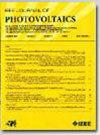Top-Performing Photovoltaic Cells Compared to the Shockley–Queisser Limit
IF 2.6
3区 工程技术
Q3 ENERGY & FUELS
引用次数: 0
Abstract
Top-performing single-junction and two-terminal tandem devices that include at least one polycrystalline cell are compared with each other and their ideal limits. The parameters of open-circuit voltage, short-circuit current, and fill-factor are individually compared to the Shockley–Queisser limit to investigate where different technologies have room to improve. Technologies, such as silicon and cadmium telluride have the most room for improvement in open-circuit voltage currently utilizing 87% and 81% of their maxima, respectively. Detailed diode and fill-factor loss analysis is presented for single-junction devices to give further insight on how they compare and where efficiency is lost. Single-crystal technologies demonstrate a fill-factor closer to the Shockley–Queisser limit than polycrystalline devices. The high diode quality factor of polycrystalline devices is the leading cause of the decreased fill-factor. Similar analysis on tandem cells with at least one thin-film cell shows that although their efficiency exceeds that of the single-junction cells, the fraction of their ideal efficiency is smaller. By comparing parameters to the Shockley–Queisser limit, it becomes clearer where certain technologies have the potential for improvement.与Shockley-Queisser极限相比,表现最好的光伏电池
包括至少一个多晶电池的性能最好的单结和双端串联器件相互比较及其理想极限。开路电压、短路电流和填充因子的参数分别与Shockley-Queisser极限进行比较,以研究不同技术有改进空间的地方。诸如硅和碲化镉等技术在开路电压方面有很大的改进空间,目前分别利用了其最大电压的87%和81%。详细的二极管和填充因子损耗分析提出了单结器件,以进一步了解他们如何比较和效率损失的地方。单晶技术的填充系数比多晶器件更接近Shockley-Queisser极限。多晶器件的高品质因数是导致填充因数降低的主要原因。对至少有一个薄膜电池的串联电池的类似分析表明,尽管它们的效率超过了单结电池,但它们的理想效率的比例更小。通过将参数与Shockley-Queisser极限进行比较,某些技术有改进潜力的地方变得更加清晰。
本文章由计算机程序翻译,如有差异,请以英文原文为准。
求助全文
约1分钟内获得全文
求助全文
来源期刊

IEEE Journal of Photovoltaics
ENERGY & FUELS-MATERIALS SCIENCE, MULTIDISCIPLINARY
CiteScore
7.00
自引率
10.00%
发文量
206
期刊介绍:
The IEEE Journal of Photovoltaics is a peer-reviewed, archival publication reporting original and significant research results that advance the field of photovoltaics (PV). The PV field is diverse in its science base ranging from semiconductor and PV device physics to optics and the materials sciences. The journal publishes articles that connect this science base to PV science and technology. The intent is to publish original research results that are of primary interest to the photovoltaic specialist. The scope of the IEEE J. Photovoltaics incorporates: fundamentals and new concepts of PV conversion, including those based on nanostructured materials, low-dimensional physics, multiple charge generation, up/down converters, thermophotovoltaics, hot-carrier effects, plasmonics, metamorphic materials, luminescent concentrators, and rectennas; Si-based PV, including new cell designs, crystalline and non-crystalline Si, passivation, characterization and Si crystal growth; polycrystalline, amorphous and crystalline thin-film solar cell materials, including PV structures and solar cells based on II-VI, chalcopyrite, Si and other thin film absorbers; III-V PV materials, heterostructures, multijunction devices and concentrator PV; optics for light trapping, reflection control and concentration; organic PV including polymer, hybrid and dye sensitized solar cells; space PV including cell materials and PV devices, defects and reliability, environmental effects and protective materials; PV modeling and characterization methods; and other aspects of PV, including modules, power conditioning, inverters, balance-of-systems components, monitoring, analyses and simulations, and supporting PV module standards and measurements. Tutorial and review papers on these subjects are also published and occasionally special issues are published to treat particular areas in more depth and breadth.
 求助内容:
求助内容: 应助结果提醒方式:
应助结果提醒方式:


